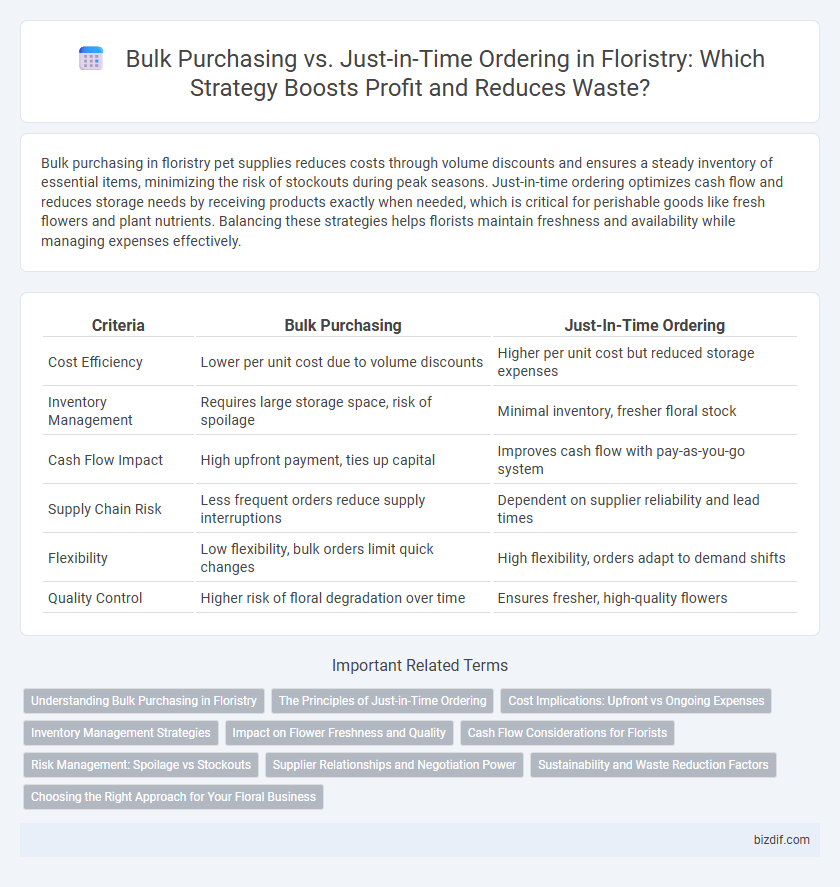Bulk purchasing in floristry pet supplies reduces costs through volume discounts and ensures a steady inventory of essential items, minimizing the risk of stockouts during peak seasons. Just-in-time ordering optimizes cash flow and reduces storage needs by receiving products exactly when needed, which is critical for perishable goods like fresh flowers and plant nutrients. Balancing these strategies helps florists maintain freshness and availability while managing expenses effectively.
Table of Comparison
| Criteria | Bulk Purchasing | Just-In-Time Ordering |
|---|---|---|
| Cost Efficiency | Lower per unit cost due to volume discounts | Higher per unit cost but reduced storage expenses |
| Inventory Management | Requires large storage space, risk of spoilage | Minimal inventory, fresher floral stock |
| Cash Flow Impact | High upfront payment, ties up capital | Improves cash flow with pay-as-you-go system |
| Supply Chain Risk | Less frequent orders reduce supply interruptions | Dependent on supplier reliability and lead times |
| Flexibility | Low flexibility, bulk orders limit quick changes | High flexibility, orders adapt to demand shifts |
| Quality Control | Higher risk of floral degradation over time | Ensures fresher, high-quality flowers |
Understanding Bulk Purchasing in Floristry
Bulk purchasing in floristry involves acquiring large quantities of flowers and supplies at once, often leading to cost savings through volume discounts and reduced shipping expenses. This strategy requires adequate storage facilities, such as refrigeration, to maintain flower freshness and minimize waste. Florists can benefit from predictable pricing and inventory availability, but must carefully manage stock turnover to avoid deterioration of perishable products.
The Principles of Just-in-Time Ordering
Just-in-time ordering in floristry focuses on acquiring flowers and supplies precisely when needed, minimizing inventory costs and reducing waste from perishable products. This method relies on accurate demand forecasting and strong supplier relationships to ensure fresh blooms are available without overstocking. By aligning purchases closely with customer orders, florists enhance freshness, profitability, and operational efficiency.
Cost Implications: Upfront vs Ongoing Expenses
Bulk purchasing in floristry reduces per-unit costs by securing lower prices for larger quantities, lowering upfront expenses but increasing storage and potential waste costs. Just-in-time ordering minimizes inventory holding costs and reduces risk of flower spoilage, shifting financial burden to ongoing supplier fees and potentially higher per-unit prices. Evaluating cost implications requires balancing capital tied in inventory against the agility and freshness maintained through frequent, smaller orders.
Inventory Management Strategies
Bulk purchasing in floristry reduces per-unit costs and ensures availability during peak seasons but risks overstocking and flower spoilage due to perishability. Just-in-time ordering minimizes waste and storage expenses by synchronizing deliveries with demand, enhancing freshness and customer satisfaction. Effective inventory management balances these strategies by analyzing sales patterns and supplier reliability to optimize stock levels and reduce losses.
Impact on Flower Freshness and Quality
Bulk purchasing in floristry often risks compromising flower freshness due to longer storage times, leading to wilting and reduced vase life. Just-in-time ordering enhances flower quality by minimizing storage duration, ensuring blooms arrive at peak freshness for immediate sale or arrangement. Maintaining optimal temperature and humidity during transport is crucial in both methods to preserve flower integrity.
Cash Flow Considerations for Florists
Bulk purchasing in floristry demands higher upfront capital but benefits from cost savings and inventory availability, positively impacting long-term cash flow stability. Just-in-time ordering reduces inventory holding costs and minimizes waste, improving short-term cash flow by freeing up working capital. Florists must assess their cash flow cycles and storage capacities to balance financial flexibility with supply reliability.
Risk Management: Spoilage vs Stockouts
Bulk purchasing in floristry reduces the risk of stockouts by ensuring a steady supply of flowers but increases the likelihood of spoilage due to excess inventory and limited shelf life. Just-in-time ordering minimizes spoilage by matching supply closely to demand, yet it heightens the risk of stockouts during unexpected surges or delivery delays. Effective risk management balances these approaches by analyzing demand patterns, supplier reliability, and storage capabilities to achieve optimal inventory levels.
Supplier Relationships and Negotiation Power
Bulk purchasing in floristry strengthens supplier relationships by fostering long-term commitments and enabling larger order volumes, which often lead to better pricing and priority service. Just-in-time ordering emphasizes flexibility and reduces inventory costs but may weaken negotiation power due to unpredictable order sizes and frequency. Strategic negotiation leverages bulk purchasing for cost savings while maintaining supplier responsiveness critical in managing perishable floral inventory.
Sustainability and Waste Reduction Factors
Bulk purchasing in floristry minimizes packaging waste and reduces carbon footprints associated with frequent deliveries, supporting sustainability goals. Just-in-time ordering limits overstock and floral spoilage by aligning inventory closely with demand, significantly cutting down organic waste. Balancing these approaches helps florists optimize supply chain efficiency while promoting environmental responsibility.
Choosing the Right Approach for Your Floral Business
Bulk purchasing in floristry ensures lower costs per stem and consistent availability of popular flowers, ideal for businesses with high volume and storage capacity. Just-in-time ordering reduces waste and preserves freshness by aligning inventory with real-time demand, best suited for boutique shops or those with limited refrigeration. Analyzing sales patterns, storage capabilities, and cash flow helps determine the optimal balance between bulk buying and just-in-time strategies to maximize profit and maintain flower quality.
Bulk purchasing vs just-in-time ordering Infographic

 bizdif.com
bizdif.com